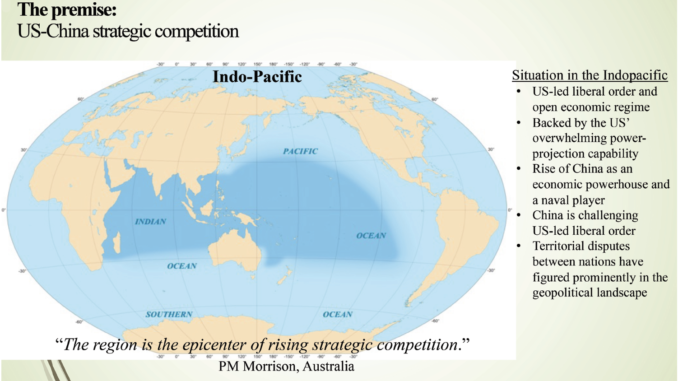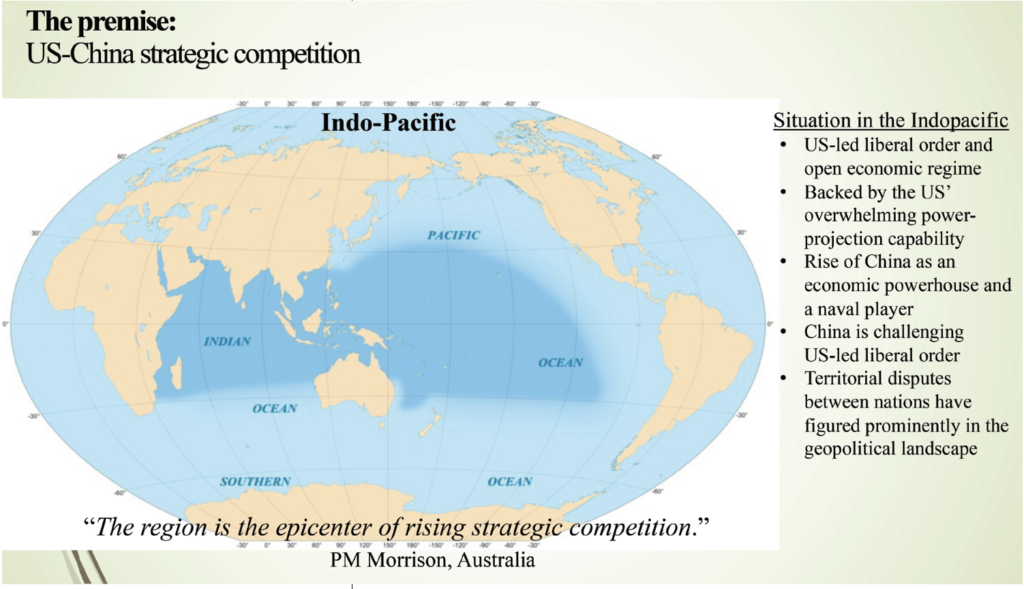
China’s militarization of the South China Sea now poses a direct threat to the Philippine archipelago by virtue of proximity.

By Gen. Emmanuel Bautista (Ret.)
(Presentation before the Pilipinas Conference, Stratbase, Nov. 25, 2021)
Allow me to share some thoughts on the topic of Ensuring Peace and Stability Through Strategic Partnerships given the context of the geopolitical rivalry and the key players in the region. And a lot of discussions has been made already earlier and I shall build upon the earlier presentations of the previous speakers.
The US-China strategic competition has a profound impact on peace and stability in the Indo-Pacific. While we have an incumbent superpower in the region, the United States, Its leadership is now being challenged by China’s rising military and economic power.
China and US diametrically opposed
And aggravating this already tense situation are flashpoints that can trigger a conflict between the two rival powers. The main rivals, US and China, are diametrically opposed in terms of vision intent, ideology, circumstances, and direction.
The US vision is a free and open Indo-Pacific with the intent of maintaining global leadership. It is the world’s only superpower and world leader. And belatedly, it rebalanced to the Indo-Pacific as it now recognizes China as its No. 1 competitor.

China’s vision
On the other hand, China’s vision is to restore its Middle Kingdom status with the intent of replacing US global leadership. It is a rising world power and is now challenging the current world order and in an aggressive westward expansion.
And while we talk about the main rivals, also mentioned earlier, there are also other significant players in the region—the middle powers—India, Australia, Japan, and South Korea. The first three are part of the quad.
South Korea’s circumstances though inhibit it from joining the quad. It is however a US ally together with Japan and Australia. Note that all of them have potential conflicts with China and this has not only further gravitated them closer to the US but has also brought them closer together.
We also have multilateral groupings—ASEAN and lately Quad and AUKUS playing a prominent role in regional dynamics. Other European powers and Canada also have stakes in the region. And with that as a backdrop, let us now go to the challenges we face.
The challenges
The principal challenge we face in the region is China’s growing assertiveness. This has led to heightened tension and a growing sense of uncertainty in terms of how far China is willing to go in pursuit of its strategic intent.
And also, how far the US will remain committed to the region. China’s assertiveness is manifested in its aggressive behavior and increased military activities. Note that China’s military activity is deliberate, it is part of a grand plan. What they are doing or what they will do they have already figured out decades ago.
Bear in mind that China is determined to implement its plan whether now or in the future when the timing and opportunity present themselves.
Consequences of China’s assertiveness
There are consequences to China’s aggressive behavior. First, there is now an increasing awareness of China’s intent and behavior and this has led to the US pivot to Asia and also the emergence of Quad and AUKUS.
The involvement of other European powers and territorial disputes are heating up and have become flashpoints that can trigger a conflict. Finally, China is getting more aggressive amidst the US and the world’s preoccupation with COVID-19.
How are our countries reacting then?
To start with, many countries are doing a balancing act in terms of accommodating both powers. While some countries can afford to stay in the middle, others are in a more difficult position and are forced to take sides.
We are also witnessing alliance formations by middle powers. There is growing pushback by those directly affected—Vietnam, Malaysia, Indonesia, and the Philippines.
Finally, we are now seeing an unprecedented level of defense spending by many countries in the region, including the Philippines.
Ramifications for the Philippines
For the Philippines in particular, the ramifications are more direct. First, a US-China confrontation will inevitably involve the Philippines because the Philippines is a mutual defense treaty with the US and regardless of whether we are a treaty, ally or not, the Philippines is a key terrain amid this competition.
And either of the protagonists will want to control the Philippine archipelago to gain a marked advantage over the other.
Second but more significantly, irrespective of the US-China rivalry, China’s territorial hegemony directly impinges on Philippine security.
Its aggressive actions have resulted in the transgression of Philippine sovereignty and sovereign rights. Its militarization of the South China Sea now poses a direct threat to the Philippine archipelago by virtue of proximity.
And even as we speak, China is employing a gray zone strategy versus the Philippines.
Opportunities
While we face challenges, there are opportunities before us—first, is the prospect of further enhancing the Philippine-US alliance.
Our alliance with the US has both strategic and operational significance at the strategic level, the alliance serves the Philippine national interest. The alliance will remain relevant for as long as there are threats to national security beyond our capabilities to address.
Given an uncertain future, there is wisdom in providing for insurance to hedge against adversities.
At the operational level, the US-Philippine alliance is central to achieving a minimum credible defense posture.
From the military perspective, the MDT (Mutual Defense Treaty) is the cornerstone of Philippine deterrence. The prospect of US intervention has dissuaded a more aggressive posture towards the Philippines. In addition, the MDT aids in the capability upgrade of the Philippine military.
There are favorable developments that contribute to an enhanced relationship. Recently there has been a marked shift in US policy manifested by its people to Asia and the recognition that China is now the No. 1 threat while this is largely driven by domestic and strategic considerations, it brings to the fore the convergence of interest between the Philippines and the United States.
Other prospects are the favorable view of Filipinos for the US providing an imprimatur for a more robust alliance. Also, the change in administration in the US and later on the possibility of one in the Philippines raises the prospect of a positive shift in policy.
What needs to be done?
First is to strengthen the cohesiveness of the alliance given the seemingly deliberate effort by external parties to weaken it. Cohesiveness is key to alliance credibility and its deterrent effect.
Second is internal. The need both countries to manage the alliance and navigate it through their respective national processes and discourse.
Third, we need to be a more responsible alliance partner. Alliances are two-way and both parties must be able to contribute their fair share to make the alliance mutually beneficial.
Fourth is to make the alliance more responsive to the evolving challenges. While the alliance was initially premised on traditional threats and therefore traditional ways of dealing with it, adjustments must now been made to make it more attuned to the gray zone nature of the current threat.
Finally, we have to ensure US quality policy continuity by deliberately trying to shape US policy.
Expanding strategic partnerships
The second opportunity before us is the prospect of expanding our strategic partnerships. Expand in terms of further strengthening existing partnerships and alliances and also in terms of more alliances and partnerships on top of what we already have.
This can either be bilateral or multilateral, including mini-laterals. There is value in expanding Philippine strategic partnerships. The logic is to advance a multilateral approach in addressing our West Philippine Sea issue. By expanding alliances and partnerships deterrence is further enhanced.
Before we are favorable prospects we can explore—one, there is now growing realization by more countries of the threat that China presents, placing them in a similar situation like us.
Moral and legal high ground from arbitral ruling
Two, the arbitral ruling of 2016 elevates us to the moral and legal high ground.
So, what can we do to make that happen?
First, we must not in any way concede this moral and legal high ground. There are actions by certain sectors that are damaging the arbitral ruling and this needs to stop.
Secondly, we need to be a more responsible member of the international community so we can leverage it to bear upon the enforcement of the rule of law.
Finally, we need more consistency of policies over a longer period of time and even over changes in administrations.
That concludes my presentation subject to your questions, clarifications, or even contrary opinion.
Thank you.
